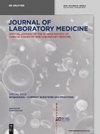利用深度神经网络自动评估免疫固定
IF 1.8
4区 医学
Q4 MEDICAL LABORATORY TECHNOLOGY
引用次数: 0
摘要
目的免疫固定电泳的可靠评估是多发性骨髓瘤实验室诊断的一部分。到目前为止,这一直是由合格的实验室工作人员进行主观评估的常规工作。主观错误的可能性和长期工作人员保留的相对较高的成本是目前普遍使用的这种方法的挑战。方法应用深度卷积神经网络对免疫固定图像进行评价。除了标准的单克隆伽玛病(IgA-Kappa、IgA-Lambda、IgG-Kappa、IgG-Lambda、IgM-Kappa和IgM-Lambda)外,还可以检测到双克隆或寡克隆伽玛病、自由链伽玛病、非病理性病例和无明确发现的病例。对这10个类中的一个的赋值带有置信度值。结果在超过4000张图像的测试数据集中,大约25%的病例被分类为不确定或由于后续人工评估的低置信度。在剩下的75%,约3000例中,没有一例被归类为假阳性,只有一例被归类为假阴性。自动评估与专家手动分配的分类的其余少数偏差是边缘情况,或者可以用其他方式解释。作为在标准台式计算机上运行的软件,深度卷积神经网络需要不到一秒钟的时间来评估免疫固定图像。结论协助实验室专家评估免疫固定图像是实验室诊断的有益补充。然而,决策权应该始终属于对结果负责的医生。本文章由计算机程序翻译,如有差异,请以英文原文为准。
Automated assessment of immunofixations with deep neural networks
Abstract Objectives The reliable evaluation of immunofixation electrophoresis is part of the laboratory diagnosis of multiple myeloma. Until now, this has been done routinely by the subjective assessment of a qualified laboratory staff member. The possibility of subjective errors and relatively high costs with long staff retention are the challenges of this approach commonly used today. Methods Deep Convolutional Neural Networks are applied to the assessment of immunofixation images. In addition to standard monoclonal gammopathies (IgA-Kappa, IgA-Lambda, IgG-Kappa, IgG-Lambda, IgM-Kappa, and IgM-Lambda), also bi- or oligoclonal gammopathies, free chain gammopathies, non-pathological cases, and cases with no clear finding are detected. The assignment to one of these 10 classes comes with a confidence value. Results On a test data set with over 4,000 images, approximately 25% of the cases are sorted out as inconclusive or due to low confidence for subsequent manual evaluation. On the remaining 75%, about 3,000 cases, not even one is classified as falsely positive, and only one as falsely negative. The remaining few deviations of the automated assessment from the classifications assigned manually by experts are borderline cases or can be explained otherwise. As a software running on a standard desktop computer, the Deep Convolutional Neural Network needs less than a second for the assessment of an immunofixation image. Conclusions Assisting the laboratory expert in the assessment of immunofixation images can be a useful addition to laboratory diagnostics. However, the decision-making authority should always remain with the physician responsible for the findings.
求助全文
通过发布文献求助,成功后即可免费获取论文全文。
去求助
来源期刊

Journal of Laboratory Medicine
Mathematics-Discrete Mathematics and Combinatorics
CiteScore
2.50
自引率
0.00%
发文量
39
审稿时长
10 weeks
期刊介绍:
The Journal of Laboratory Medicine (JLM) is a bi-monthly published journal that reports on the latest developments in laboratory medicine. Particular focus is placed on the diagnostic aspects of the clinical laboratory, although technical, regulatory, and educational topics are equally covered. The Journal specializes in the publication of high-standard, competent and timely review articles on clinical, methodological and pathogenic aspects of modern laboratory diagnostics. These reviews are critically reviewed by expert reviewers and JLM’s Associate Editors who are specialists in the various subdisciplines of laboratory medicine. In addition, JLM publishes original research articles, case reports, point/counterpoint articles and letters to the editor, all of which are peer reviewed by at least two experts in the field.
 求助内容:
求助内容: 应助结果提醒方式:
应助结果提醒方式:


